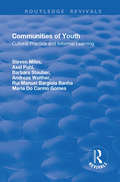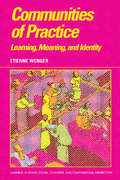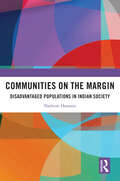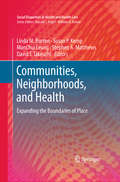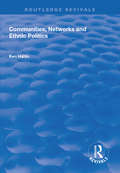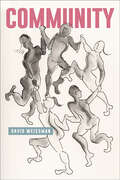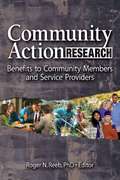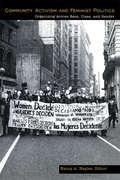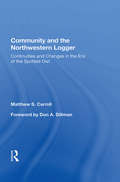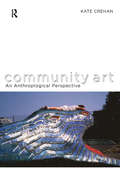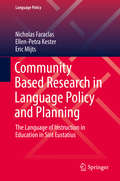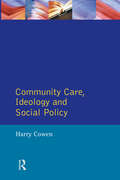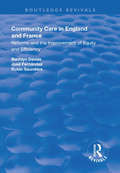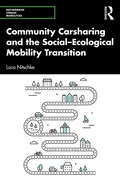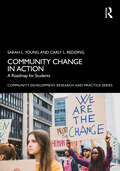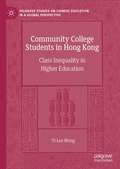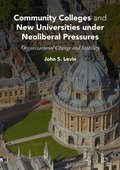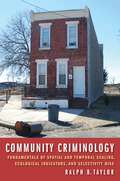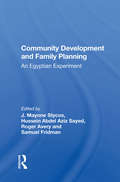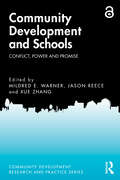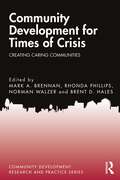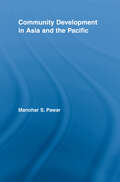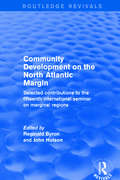- Table View
- List View
Communities of Youth: Cultural Practice and Informal Learning (Routledge Revivals)
by Steven Miles Barbara Stauber Andreas Walther Axel Pohl Rui Manuel Banha Maria do GomesThis title was first published in 2002.Communities of Youth critically evaluates what it means to be a young person at the beginning of the twenty-first century and the problems, opportunities and dilemmas that emerge from the experience. The book is concerned with putting key conceptual debates to do with youth in a comparative cutting-edge empirical context. In particular, it endeavours to transcend what its contributors feel is one of the most damaging trends of recent work on the question of youth, namely: the division between young people’s transitions and youth culture. Building upon the notion of lifestyle as a means of bridging this gap, the book provides something original and timely: a way of linking young people’s broader structural concerns with the cultural and community contexts within which they conduct their everyday lives. The data discussed in the book emanates from a comparative European Union project conducted in Great Britain, Germany and Portugal. The three training programmes examined are based on the performing arts, but the authors argue that the skills young people glean from these courses are more to do with generic skills such as the ability to work effectively in groups, mutual responsibility, discipline and above all, confidence, than the technical proficiencies of performance. These courses become an important part of the young people’s lives and as such, provide a space within which they become themselves . In this sense, the book highlights the fact that far from being passive recipients of public policy, young people actively engage with the power structures that combine to shape their lives. Communities of Youth therefore considers the diversity of European youth and by tapping into this diversity it develops important recommendations that will inform academic debate, research and youth policy.
Communities of practice: Learning, Meaning, And Identity (Learning In Doing Ser.)
by Etienne WengerLearning is becoming an urgent topic. Nations worry about the learning of their citizens, companies about the learning of their workers, schools about the learning of their students. But it is not always easy to think about how to foster learning in innovative ways. This book presents a framework for doing that, with a social theory of learning that is ground-breaking yet accessible, with profound implications not only for research, but also for all those who have to foster learning as part of their responsibilites at work, at home, at school.
Communities on the Margin: Disadvantaged Populations in Indian Society
by Saiyed Nadeemul HasnainThis book probes into the marginalized communities of the Indian society through historical and contemporary societal perspectives. It discusses socio-cultural aspects of the experiences of Scheduled Castes, Dalits, Scheduled Tribes/tribal communities, Other Backward Classes, linguistic minorities, religious minorities and the queer/LGBT as sexual minorities.Adopting an inter-disciplinary approach, it looks at all these segments of Indian society through historical and societal perspectives. Divided into three broad sections – Scheduled Castes, Scheduled Tribes, and minorities, this book provides historical perspective backed by the contemporary situation and emerging social changes among these communities. Written in a lucid manner, the book aims to reach and impact readers without having any prior academic exposure to this subject area.This book would be useful to the students, researchers and teachers of sociology, social work, history, economics, political science, and other interdisciplinary courses in social sciences. The book will also be valuable reading for those interested in South Asian studies, especially contemporary Indian society.
Communities, Neighborhoods, and Health: Expanding the Boundaries of Place (Social Disparities in Health and Health Care #1)
by Stephen A. Matthews Linda M. Burton David T. Takeuchi Manchui Leung Susan P. KempPlace is an important element in understanding health and health care disparities. More that merely a geographic location, place is a socio-ecological force with detectable effects on social life, independent well-being, and health. Despite the general enthusiasm for the study of place and the potential it could have for a better understanding of the distribution of health in different communities, research is at a difficult crossroads because of disagreements in how the construct should be conceptualized and measured. This edited volume incorporates an cross-disciplinary approach to the study of place, in order to come up with a comprehensive and useful definition of place. Topics covered include: Social Inequalities, Historical Definitions of Place, Biology and Place, Rural vs. Urban Places, Racialization of a Place, Migration, Sacred Places, Technological Innovations An understanding of place is essential for health care professionals, as interventions often do not have the same effects in the clinic as they do in varied, naturalistic social settings.
Communities, Networks and Ethnic Politics (Routledge Revivals)
by Ken HahloFirst Published in 1998, this study explores ethnic community political participation in local politics in the North West British town. The analysis is located within the framework of the shift from Fordism to post-Fordism.From 1965 to 1980 ethnic communities increased their access to scarce resources including political influence by engaging in ethnic politics. Using membership of religious organisations as structures of support, elected men deployed ethnic identities to compete with others for ethnic support and influence over local decision-making processes. This gave ethnic minorities a positive role in local politics. With the support of local community relations councils (CRCs), ethnic politics flourished. It gave ethnic communities real opportunities to participate as ethnic communities in politics. Using local events, ethnic leaders competed for political influence and ethnic support. After 1977 the shift from Fordism to post-Fordism brought about a decline in ethnic political participation. While conferment of citizenship secured their right to stay in Britain, the rise in consumerism undermined the manufacturing sector on which they depended for work. With no ethnic political identity, today, these communities are again politically disadvantaged.
Community
by David WeissmanCommunities are vital to personal and social well-being because collaboration is required where skills and resources are scarce; their pathologies—anonymity and isolation, tribalism and murder—defeat us.Community is often invoked respectfully but without a clear referent. The word is said to be used ninety-four ways, evidence that its sense is diffuse. Community clarifies the word's principal expressions and the alternative ideological spaces-holistic and hierarchical or open and tolerant-in which communities form. Members bind in the interest of utility-jobs or schools-or because home and friendship are the focus of feeling and significance. These binders are social glue: they explain our dedication to communal aims and loyalty to fellow members. Autonomy in their context is socialized; its bases are the information, attitudes, and skills acquired when families and schools prepare us for roles in communities inherited or chosen. Yet community is fraught. Holistic societies are repressive; open societies are vulnerable. The members of successful communities-families, businesses, and schools-often thrive. Those excluded for want of luck or skill are abandoned and anonymous. Their isolation is one of an open society's two pathologies: collaboration is a social necessity when resources, space, and skills are scarce; competition turned visceral and murderous is a vice.
Community Action Research: Benefits to Community Members and Service Providers
by Roger N. ReebDiscover how to better help those in your community in need of servicesCommunity Action Research comprehensively explores models for community action research, incorporating quantitative and qualitative research to highlight the advantages to community members as well as the volunteers/paraprofessionals who implement the services. Respected experts present the latest research on the fulfillment of the needs of community members as well as the benefits to the volunteers and paraprofessionals, including psychological empowerment, psychological sense of community, and other facets of personal development.Community Action Research is helpfully organized into two sections. The first section presents a sample of empirical studies that examines whether community action research demonstrated benefits for community members. The second section provides empirical studies that show the positive impact of community action research on the personal development of volunteers and paraprofessionals who provided the research-related services. This detailed text is carefully referenced and uses several tables to enhance understanding of research data. Community Action Research discusses: the Adolescent Diversion Project as an alternative to juvenile court home-based behavior modification programs for autistic children the People Awakening Project and the role paraprofessionals played in Alaska Native sobriety a crime prevention project launched by a residential neighborhood association the Actual Community Empowerment Reading Program which utilized community members as literacy tutors the Community Service Self-Efficacy Scale&’s reliability and validity the Hawaiian Studies Program&’s weekly participation in community service-learning exercises and more!Community Action Research is insightful reading for psychologists, sociologists, social workers, criminal justice researchers and professionals, community counselors, practitioners and researchers in community prevention and intervention, clinical supervisors, service learning specialists, educators, students, and mental health and human services program administrators, planners, or evaluators.
Community Activism and Feminist Politics: Organizing Across Race, Class, and Gender (Perspectives on Gender)
by Nancy NaplesThis collection demonstrates the diversity of women's struggles against problems such as racism, violence, homophobia, focusing on the complex ways that gender, culture, race-ethnicity and class shape women's political consciousness in the US.
Community And The Northwestern Logger: Continuities And Changes In The Era Of The Spotted Owl
by Matthew S. CarrollIt has often been said that natural resource and environmental problems cannot be solved without solving human problems. In this book, Matthew Carroll examines the economic and social circumstances of northwestern U.S. loggers in the face of shifts in environmental politics, dramatic reductions in timber harvest levels on federal lands, and changing technology and market forces—among other factors that are rapidly transforming their industry, their livelihoods, and their communities. Drawing upon sociological fieldwork in logging communities that he conducted at various times over a period of nearly a decade and using the spotted owl-old growth controversy as a case study, Carroll provides a rich and detailed picture of life among northwestern loggers. He lays out the human dimensions and dilemmas of the timber crisis. Expanding it from the oversimplified owl-versus- logger confrontation, he puts these issues in a historical and policy context and suggests parallels to other controversies such as public grazing and federal or state river protection. Carrol’s work revives the concept of occupational community and shows ways it can be used to understand the dynamics of rural occupations linked to resource extraction.
Community Art: An Anthropological Perspective
by Kate CrehanExploring key issues for the anthropology of art and art theory, this fascinating text provides the first in-depth study of community art from an anthropological perspective.The book focuses on the forty year history of Free Form Arts Trust, an arts group that played a major part in the 1970s struggle to carve out a space for community arts in Britain. Turning their back on the world of gallery art, the fine-artist founders of Free Form were determined to use their visual expertise to connect, through collaborative art projects, with the working-class people excluded by the established art world. In seeking to give the residents of poor communities a greater role in shaping their built environment, the artists' aesthetic practice would be transformed.Community Art examines this process of aesthetic transformation and its rejection of the individualized practice of the gallery artist. The Free Form story calls into question common understandings of the categories of "art," "expertise," and "community," and makes this story relevant beyond late twentieth-century and early twenty-first-century Britain.
Community Based Research in Language Policy and Planning: The Language of Instruction in Education in Sint Eustatius (Language Policy #20)
by Nicholas Faraclas Ellen-Petra Kester Eric MijtsThis volume focuses on a case where community organizing, academic research and governmental responsibility were successfully mobilized and synchronized to bring about change in educational policy and practice. The focus of this book is the methodology implemented and the results obtained over the course of a year-long action research project on language and education in St. Eustatius, one of the islands of the Dutch Caribbean, commissioned by the educational authorities in both St. Eustatius and the European Netherlands. On the island, the language of instruction is Dutch, however, outside of the classroom most students only speak English and an English-lexifier Creole. The research project was set up to address the negative impact on school success of this disparity. It included a community-based sociolinguistic study that actively involved all of the stakeholders in the education system on the island. This was complemented by a multi-pronged set of research strategies, including a language attitude and use survey, a narrative proficiency test, in depth interviews, and a review of the relevant literature. The resulting report and recommendations were accepted by the government, which is now in the process of changing the language of instruction.
Community Biodiversity Management: Promoting resilience and the conservation of plant genetic resources (Issues in Agricultural Biodiversity)
by Walter Simon de Boef Abishkar Subedi Nivaldo Peroni Marja Thijssen Elizabeth O’KeeffeThe conservation and sustainable use of biodiversity are issues that have been high on the policy agenda since the first Earth Summit in Rio in 1992. As part of efforts to implement in situ conservation, a methodology referred to as community biodiversity management (CBM) has been developed by those engaged in this arena. CBM contributes to the empowerment of farming communities to manage their biological resources and make informed decisions on the conservation and use of agrobiodiversity. This book is the first to set out a clear overview of CBM as a methodology for meeting socio-environmental changes. CBM is shown to be a key strategy that promotes community resilience, and contributes to the conservation of plant genetic resources. The authors present the underlying concepts and theories of CBM as well as its methodology and practices, and introduce case studies primarily from Brazil, Ethiopia, France, India, and Nepal. Contributors include farmers, leaders of farmers’ organizations, professionals from conservation and development organizations, students and scientists. The book offers inspiration to all those involved in the conservation and use of agrobiodiversity within livelihood development and presents ideas for the implementation of farmers’ rights. The wide collection of experiences illustrates the efforts made by communities throughout the world to cope with change while using diversity and engaging in learning processes. It links these grassroots efforts with debates in policy arenas as a means to respond to the unpredictable changes, such as climate change, that communities face in sustaining their livelihoods.
Community Care Social Policy & Ideology
by Harry CowenThis book offers a comprehensive evaluation of community care strategies within the context of government social policy, and assesses the recent shifts of political power from Conservative to Labour towards the end of the century. Unlike the majority of texts in the field of community care, it makes explicit the historical, philosophical, social and political inter-connections, and therefore provides an in-depth understanding of changing policy issues for students, practicioners and managers in health and social care.
Community Care in England and France: Reforms and the Improvement of Equity and Efficiency (Routledge Revivals)
by Bleddyn Davies José FernándezFirst published in 1998, the aims of this book are: the comparison of community care service and financing systems, the comparison of reform arguments and history over the last decade, the comparison of who uses how much of what services, and with what impact on their needs and the probability of having to enter institutions for long-term care. The book breaks new ground by comparing systems from a new perspective and describing contemporary reform argument and proposals for the first time in the English language. It presents new evidence from the most ambitious collection and analysis of quantative data so far made for the comparison of the two countries (based on matched area samples collecting comparable information about cohorts of new users on two or more occasions). The book also shows how the need-related circumstances of users differ between countries and within each country between areas. The book shows how and why higher levels of the French cash benefit for community care had more effect on the central policy goal than its British counterpart, how higher levels of services generally had little impact on it in either country, but on average, how the effect of the British services were much greater.
Community Carsharing and the Social–Ecological Mobility Transition (Networked Urban Mobilities Series)
by Luca NitschkeThis book investigates how practices of community carsharing are influencing everyday mobility. It argues that hegemonic practices of automobility are reconfigured through practices of community carsharing, thereby challenging capitalist mobilities in the realm of everyday life. Through a detailed empirical study of practices of community carsharing and its practitioners in the rural regions around Munich, Germany, this book reveals how the practice contributes to the emergence of alternative automobile practices, meanings, identities and subjectivities. It also explores the embedding of automobility into its ecological context, the connection of function and community in practices of community carsharing and the changing of ownership relations through a process of commoning mobility. This reconfiguration of everyday practices of automobility takes place through processes of everyday resistance, re-embedding and commoning, and ultimately results in the emergence of an alternative mobility culture, thereby facilitating the dissemination of an alternative common sense of community carsharing. This book on community carsharing provides a valuable insight into carsharing in rural settings and exemplifies how carsharing specifically, and sharing mobilities in general, can contribute to a social–ecological mobility transition. The work will be of particular interest to scholars and practitioners working in mobility studies and mobilities.
Community Change in Action: A Roadmap for Students (Community Development Research and Practice Series)
by Sarah L. Young Carly L. ReddingCommunity Change in Action guides students through the process of turning their personal passion into goal-driven action for community development. Using an evidence-based curriculum, the book breaks down exactly how to initiate and drive social change in a way that speaks to the unique characteristics of Generation Z (Gen Z).Each chapter provides step-by-step actions, analyzes real-life examples, and supplies the necessary tools for success. The authors' multiple decades of experience leading students in community development, both in the United States and abroad, spawn a rich and engaging source for these examples. Each step is highlighted through Gen Z's narrated examples of using the guide and the associated toolkits to implement major social change initiatives, from Native American reservations to the slums of India and beyond.This book takes best practice approaches to youth leadership, community development, and social change beyond the classroom, inspiring and illustrating how Gen Z students can take their passion and turn it into social action.
Community College Students in Hong Kong: Class Inequality in Higher Education (Palgrave Studies on Chinese Education in a Global Perspective)
by Yi-Lee WongThis book presents a comprehensive account of the educational experiences of community college students in Hong Kong, analyzed through a theoretical lens that intersects sociological theories of inequality, including Bourdieu's concept of cultural capital. The student narratives featured in this book reveal the interweaving personal, academic, and professional considerations and challenges affecting their individual choices in the pursuit of higher education. Chapters also reveal why, despite the relative expansion of educational opportunities, the class gap in higher education persists.
Community Colleges and New Universities under Neoliberal Pressures: Organizational Change and Stability
by John S. LevinThis book examines seven higher education organizations, exploring their interconnected lines: organizational change and organizational stability. These lines are nested within historical, social, cultural, and political contexts of two nations--the US and Canada--two provinces and three states: Alberta, British Columbia, California, Hawai'i, and Washington. The author studies the development of the community college and the development of the university from community college origins, bringing to the forefront these seven individual stories. Addressing continuity and discontinuity and identity preservation and identity change, as well as individual organizations' responses to government policy, Levin analyzes and illuminates those policies with neoliberal assumptions and values.
Community Criminology: Fundamentals of Spatial and Temporal Scaling, Ecological Indicators, and Selectivity Bias (New Perspectives in Crime, Deviance, and Law #12)
by Ralph B. TaylorFor close to a century, the field of community criminology has examined the causes and consequences of community crime and delinquency rates. Nevertheless, there is still a lot we do not know about the dynamics behind these connections. In this book, Ralph Taylor argues that obstacles to deepening our understanding of community/crime links arise in part because most scholars have overlooked four fundamental concerns: how conceptual frames depend on the geographic units and/or temporal units used; how to establish the meaning of theoretically central ecological empirical indicators; and how to think about the causes and consequences of non-random selection dynamics. The volume organizes these four conceptual challenges using a common meta-analytic framework. The framework pinpoints critical features of and gaps in current theories about communities and crime, connects these concerns to current debates in both criminology and the philosophy of social science, and sketches the types of theory testing needed in the future if we are to grow our understanding of the causes and consequences of community crime rates. Taylor explains that a common meta-theoretical frame provides a grammar for thinking critically about current theories and simultaneously allows presenting these four topics and their connections in a unified manner. The volume provides an orientation to current and past scholarship in this area by describing three distinct but related community crime sequences involving delinquents, adult offenders, and victims. These sequences highlight community justice dynamics thereby raising questions about frequently used crime indicators in this area of research. A groundbreaking work melding past scholarly practices in criminology with the field’s current needs, Community Criminology is an essential work for criminologists.
Community Development And Family Planning: An Egyptian Experiment
by J. Mayone StycosProgram evaluation is not among the most popular of exercises, since it carries risks for all associated with it. Because every important program has friends and enemies anxious for its prosperity or demise, the investigators and their findings will normally be attacked from at least one side and not infrequently from both. But this is an occupational hazard, dutifully accepted by its practitioners; for some it even adds a zestful touch of danger. However, the program's sponsors and its participants require an unusual degree of courage, since negative or indifferent results are not infrequently used to impugn their wisdom or dedication. We applaud the courage of all those who, in the interest of improving policies and programs to further their clients' well-being, assumed the risks of introducing scientific program evaluation: Primary credit goes to the sponsor of the current research, the United Nations Fund for Population Activities (UNFPA), in particular the Mediterranean and Middle East Branch and its chief, Roushdi El Henedi. Special thanks go to Dr. Habib Siddiqui for his stimulus in launching the study. His efforts were followed by those of M.A. Abu-Nuwar, whose bureaucratic and diplomatic skills were much appreciated, and Sylvia Rhodes, who was of assistance near the close of the project. UNFPA staff in Egypt, in particular Hamed Fahmy, were most helpful in the field. Needless to say, neither these individuals nor the UNFPA necessarily agree with the conclusions reached in this book.
Community Development and Schools: Conflict, Power and Promise (ISSN)
by Mildred E. Warner Xue Zhang Jason ReeceThis book lays out the promise and potential of schools as community-building institutions. It explores the challenges faced in incorporating schools into broader community development policy, and also recognizes the changing demographics of schools and their need to integrate with economic development policy in order to promote broader community development.The book includes chapters on tax abatements and economic development policy impacts on schools, new approaches to school building renovation, the potential and reach of shared services between communities and schools, and the impact of school-based health centers. It also offers a theory to integrate schools into community development. Key elements include shared power between communities and schools, greater transparency in economic development policy, collaboration across the broad range of community actors, and engagement of diverse voices. These elements build a greater sense of belonging across generations and class and racial divides.Creative democracy can broaden both school and community development agendas and build a culture of health. This book will help community development and school leaders recognize and pursue the promise of schools as critical community development actors.The Open Access version of this book, available at http://www.taylorfrancis.com, has been made available under a Creative Commons Attribution-Non Commercial (CC-BY-NC) 4.0 license.
Community Development for Times of Crisis: Creating Caring Communities (Community Development Research and Practice Series)
by Mark A. BrennanThis book explores the intersection of community development and local capacity building as a basis for effective disaster mitigation and the alleviation of suffering in times of crisis. Beginning with the Community Development section, the process, context, and methods for community, engagement, and development can be viewed from different structural and logical approaches. This section explores some of the more relevant historical arguments, as well as more contemporary examinations. The second section looks at Critical Human and Community Considerations and sheds light on some of the key concepts that are often overlooked (poverty, race, inequality, social justice, mental health, social division) when framing community responses to disaster. The third section focuses on Fundamental Elements of Caring Communities. This section explores the importance, practical, and measurable impacts of social support, empathy, inclusion, and conflict resolution in creating effective and caring community responses. Finally, the last section focuses on practice and brings together research and theory into applied programming, examples, and evidence from on-the-ground efforts to establish caring communities that respond to local needs in times of crisis and beyond. By addressing these objectives, this book provides a more complete understanding of the essential role that community can play in disaster mitigation. Doing this will provide a better focus for ongoing research endeavors, and program and policy initiatives at the community level that seek to prepare for, respond to, and recover from natural and other disasters. As a result, this book contributes to wider and more sustainable development of our communities beyond disasters, while furthering dialog among community scholars and practitioners.
Community Development in Asia and the Pacific (Routledge Studies in Development and Society)
by Manohar S. PawarThere is a tremendous need for community development practice in the Asia-Pacific region due to its size and prevailing diverse socio-economic, political and cultural needs and issues. Both developed and developing countries have been reemphasizing the importance of community development and have introduced several schemes or programs for overall development. Manohar Pawar familiarizes readers with the region, presents the major social, economic and political issues, looks at values and principles, and critically analyses challenges and shows opportunities for community development practice in the region. This book will allow for anyone interested in community development both at local and global levels – scholars, non-government organizations (NGOs), government organisations, international aid agencies – to gain a broad understating of community development trends in the Asia-Pacific region.
Community Development in an Uncertain World
by Jim IfeCommunity Development in an Uncertain World provides a comprehensive and lively introduction to modern community development. The book explores the interrelated frameworks of social justice, ecological responsibility and post-Enlightenment thinking, drawing on various sources including the wisdom of Indigenous peoples. Recognising the increasing complexity and uncertainty of the times in which we live, Jim Ife promotes a holistic approach to community development and emphasises the different dimensions of human community: social, economic, political, cultural, environmental, spiritual, personal and survival. The first section of the book examines the major theories and concepts that underpin community development. This includes a discussion of core principles: change and wisdom 'from below', the importance of process and valuing diversity. The second section focuses on practical elements, such as community work roles and essential skills. The final chapters discuss the problematic context of much contemporary practice and offer vision and hope for the future.
Community Development on the North Atlantic Margin: Selected Contributions to the Fifteenth International Seminar on Marginal Regions (Routledge Revivals)
by John Hutson Reginald ByronThis title was first published in 2001. Isolated communities, dependent upon fishing, farming and forestry, which are scattered around the North Atlantic coast, have shared a disastrous decline during the last decade. These communities are in the peripheries of advanced industrial nation-states, such as Canada and supra-national alliances, such as the European Community, yet despite this, there are no easy solutions to the development of these regions. This volume argues that the productive assets of these regions, and how they can be used to sustain household incomes, need to be better understood. The assets need to be converted into products and services and they need to be marketed profitably. The diminshing flow of young people who leave these areas to obtain higher education and who do not return must be turned around and efforts must be concentrated on the creation or strengthening of economic conditions which satisfy the younger generation's employment aspirations, consumer requirements and social needs.
